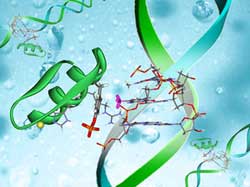Decoding DNA’s annotations

Figure 1: The Sp1 peptide probe (left) binds a DNA strand (right) and reveals the presence of an epigenetic marker that is a methyl group (purple). Copyright : 2011 Akimitsu Okamoto<br>
In the currently hot research area known as ‘epigenetics’, researchers are discovering that offspring inherit much more from their parents than just their genes. Individuals also inherit detailed instructions on how to use the genetic sequence coded in their DNA via small chemical, or epigenetic, markers that decorate DNA strands.
The markers can activate some genes and switch off others. Epigeneticists are racing to decode the roles of different markers; but, first, they must develop the ability to read them. A new chemical probe, developed by a research team led by Akimitsu Okamoto at the RIKEN Advanced Science Institute, Wako, is showing promise as an analytical tool to assist this quest1.
The team’s probe can differentiate between two epigenetic markers—methyl and hydroxymethyl markers—that differ by the presence of a single oxygen atom. Methyl groups, one of the first epigenetic markers discovered, are known to inactivate gene expression; ‘demethylation’, or removal of a methyl group from the DNA, allows gene expression to restart.
“We know the mechanism of DNA methylation, but nobody knows the mechanism of DNA demethylation,” Okamoto explains. One possibility is that the body converts the methyl marker into a hydroxymethyl group, as the first step in the process of removing it, in preparation to reactivate a gene. However, current tests cannot distinguish between the two epigenetic markers, preventing that theory from being tested.
The chemical probe developed by Okamoto and colleagues is based on a peptide called Sp1, which is known to bind to DNA. The researchers previously modified the structure of Sp1 so that it adheres strongly only to DNA strands incorporating a methyl marker (Fig. 1). They then showed that if the peptide binds to a DNA strand, it reveals the presence of the methyl group2.
In their latest study, the researchers showed that modified Sp1 will not bind to DNA when the methyl group is converted to a hydroxymethyl—thereby allowing them to tell the two groups apart. The extra oxygen atom in the hydroxymethyl group disrupts the interaction between the peptide and the DNA, so the two cease to adhere together.
Okamoto and his colleagues are now planning to modify the peptide to detect an even wider range of epigenetic markers, which will allow the study of their role in gene expression. “Our next step is to develop the methods for effective sequencing and detection of DNA containing cytosine, 5-methylcytosine, 5-hydroxymethylcytosine, 5-formylcytosine, and 5-carboxycytosine,” Okamoto says.
The corresponding author for this highlight is based at the Nucleic Acid Chemistry Laboratory, RIKEN Advanced Science Institute
Media Contact
All latest news from the category: Life Sciences and Chemistry
Articles and reports from the Life Sciences and chemistry area deal with applied and basic research into modern biology, chemistry and human medicine.
Valuable information can be found on a range of life sciences fields including bacteriology, biochemistry, bionics, bioinformatics, biophysics, biotechnology, genetics, geobotany, human biology, marine biology, microbiology, molecular biology, cellular biology, zoology, bioinorganic chemistry, microchemistry and environmental chemistry.
Newest articles

Machine learning algorithm reveals long-theorized glass phase in crystal
Scientists have found evidence of an elusive, glassy phase of matter that emerges when a crystal’s perfect internal pattern is disrupted. X-ray technology and machine learning converge to shed light…

Mapping plant functional diversity from space
HKU ecologists revolutionize ecosystem monitoring with novel field-satellite integration. An international team of researchers, led by Professor Jin WU from the School of Biological Sciences at The University of Hong…

Inverters with constant full load capability
…enable an increase in the performance of electric drives. Overheating components significantly limit the performance of drivetrains in electric vehicles. Inverters in particular are subject to a high thermal load,…





















